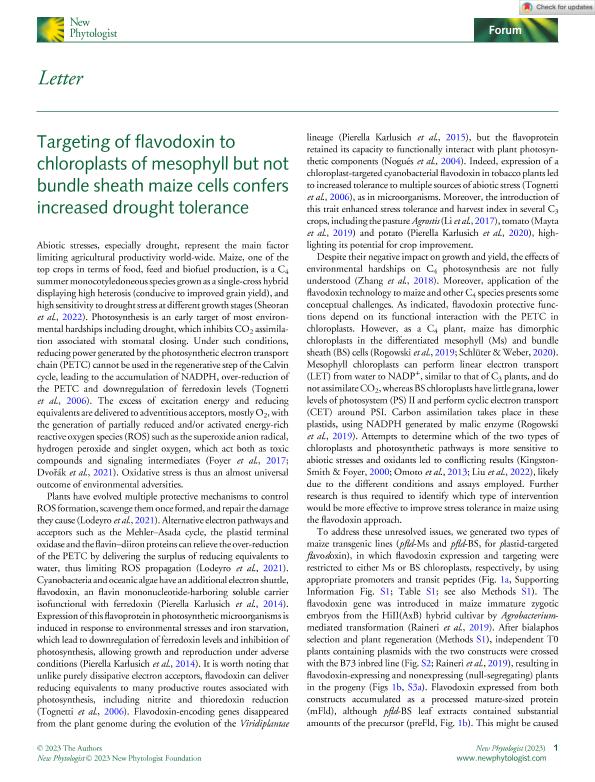Artículo
Targeting of flavodoxin to chloroplasts of mesophyll but not bundle sheath maize cells confers increased drought tolerance
Demarchi, Mariana ; Arce, Rocio Cecilia
; Arce, Rocio Cecilia ; Campi, Mabel
; Campi, Mabel ; Pierella Karlusich, Juan José
; Pierella Karlusich, Juan José ; Hajirezaei, Mohammad Reza; Melzer, Michael; Lodeyro, Anabella Fernanda
; Hajirezaei, Mohammad Reza; Melzer, Michael; Lodeyro, Anabella Fernanda ; Chan, Raquel Lia
; Chan, Raquel Lia ; Carrillo, Nestor Jose
; Carrillo, Nestor Jose
 ; Arce, Rocio Cecilia
; Arce, Rocio Cecilia ; Campi, Mabel
; Campi, Mabel ; Pierella Karlusich, Juan José
; Pierella Karlusich, Juan José ; Hajirezaei, Mohammad Reza; Melzer, Michael; Lodeyro, Anabella Fernanda
; Hajirezaei, Mohammad Reza; Melzer, Michael; Lodeyro, Anabella Fernanda ; Chan, Raquel Lia
; Chan, Raquel Lia ; Carrillo, Nestor Jose
; Carrillo, Nestor Jose
Fecha de publicación:
10/2023
Editorial:
Wiley Blackwell Publishing, Inc
Revista:
New Phytologist
ISSN:
0028-646X
Idioma:
Inglés
Tipo de recurso:
Artículo publicado
Clasificación temática:
Resumen
Photosynthetic metabolism in C4 plants is split between two types of dimorphic cells and chloroplasts, with mesophyll chloroplasts performing linear electron transport from water to NADP+, similar to that of C3 plants, and bundle sheath plastids, which have little grana and photosystem II, performing cyclic electron transport and CO2 assimilation. While the negative effects of environmental stresses on C3 photosynthesis are extensively documented, information regarding the stress effects on C4 photosynthetic pathways is scarce and somehow contradictory. We propose in this article a strategy to improve stress tolerance in the main C4 crop, maize, with a minimum of genetic intervention. It is based on the tissue-specific expression of a cyanobacterial flavodoxin, an alternative electron shuttle which prevents over-reduction of the photosynthetic electron transport chain (PETC) under stress, and has been shown to increase stress tolerance in C3 crop and model species. By interacting with the PETC, flavodoxin could be used as a tool to identify which type of C4 photosynthetic pathway is more sensitive to environmental and oxidative challenges.Main questions addressed are therefore: i) which type of genetic modification(s) can provide increased drought and oxidative stress tolerance, and ii) which type of photosynthetic pathway, cell, chloroplast, etc., is more sensitive to environmental hardships in C4 plants.The article reports that flavodoxin does improve stress tolerance in maize, but only when expressed in mesophyll plastids, suggesting that lineal electron transport is the most stress-sensitive pathway, and the one that profits more from flavodoxin interaction. The results reported here open novel avenues of crop improvement in the face of harsher conditions and global climate change affecting sub-irrigated cultivation lands. In addition to its biotech relevance, the results illustrate the use of flavodoxin as a tool to further investigate the response and sensitivity of the different C4 photosynthetic pathways to environmental inputs, a largely unexplored field.
Archivos asociados
Licencia
Identificadores
Colecciones
Articulos(IAL)
Articulos de INSTITUTO DE AGROBIOTECNOLOGIA DEL LITORAL
Articulos de INSTITUTO DE AGROBIOTECNOLOGIA DEL LITORAL
Articulos(IBR)
Articulos de INST.DE BIOLOGIA MOLECULAR Y CELULAR DE ROSARIO
Articulos de INST.DE BIOLOGIA MOLECULAR Y CELULAR DE ROSARIO
Citación
Demarchi, Mariana; Arce, Rocio Cecilia; Campi, Mabel; Pierella Karlusich, Juan José; Hajirezaei, Mohammad Reza; et al.; Targeting of flavodoxin to chloroplasts of mesophyll but not bundle sheath maize cells confers increased drought tolerance; Wiley Blackwell Publishing, Inc; New Phytologist; 240; 6; 10-2023; 2179-2184
Compartir
Altmétricas



